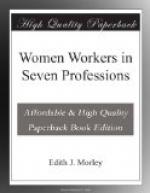The nature of the work asked of the teachers in primary schools, has led to insistence by the State on the necessity for their professional training, as well as for their academic proficiency. These requirements have met with the counter-demand on the part of the teachers in State schools, for State registration. When this Register,[2] now in process of creation, has become an accomplished fact, one of the chief remaining obstacles to the progress of the teaching service will be removed.
It is now time to turn to the conditions of training, service, and remuneration prevailing in English and Welsh elementary schools. The Scotch service differs in some respects, while the state of primary education and the position of elementary teachers in Ireland[3] are altogether worse than in Great Britain.
The Board of Education recognises the following grades of men and women teachers in public elementary schools: pupil teachers, bursars and student teachers, uncertificated teachers, and certificated teachers. Women, over eighteen years of age, who have been vaccinated, may, without any other qualifications, be engaged as supplementary teachers, although the Board cannot entertain any application for the recognition of men in this capacity. A supplementary teacher may teach (I) infants’ classes, that is to say, classes in which the majority of the scholars are under eight years of age, or (2) the lowest class of older scholars in a school or department in a rural parish, if the average attendance in the school does not exceed 100.
The number of supplementary teachers employed in the schools of England and Wales in the year 1910-11 was 14,454.
If we turn to uncertificated teachers, we find that during the year 1909-10 there were 45,549 employed in the schools of England and Wales, and that this number was increased by 182 during the year 1910-11. Of the uncertificated teachers of England in the year 1910-11, 5,106 were men and 35,222 were women.
The vast majority of rural schools have only one certificated teacher on the staff, and in hundreds of rural schools the head teacher is not certificated.
The following statistics with regard to certificated
teachers have
been taken from the published return of the Board
of Education,
1910-11:[4]—
England.
Wales.
Men.
Women. Men. Women.




